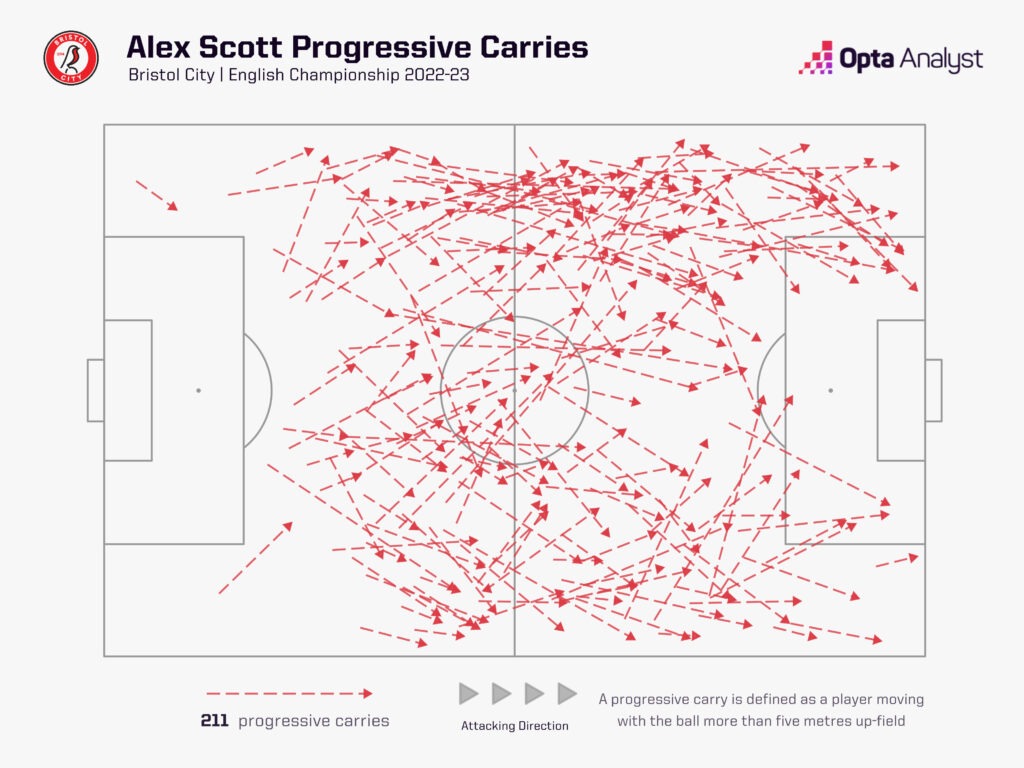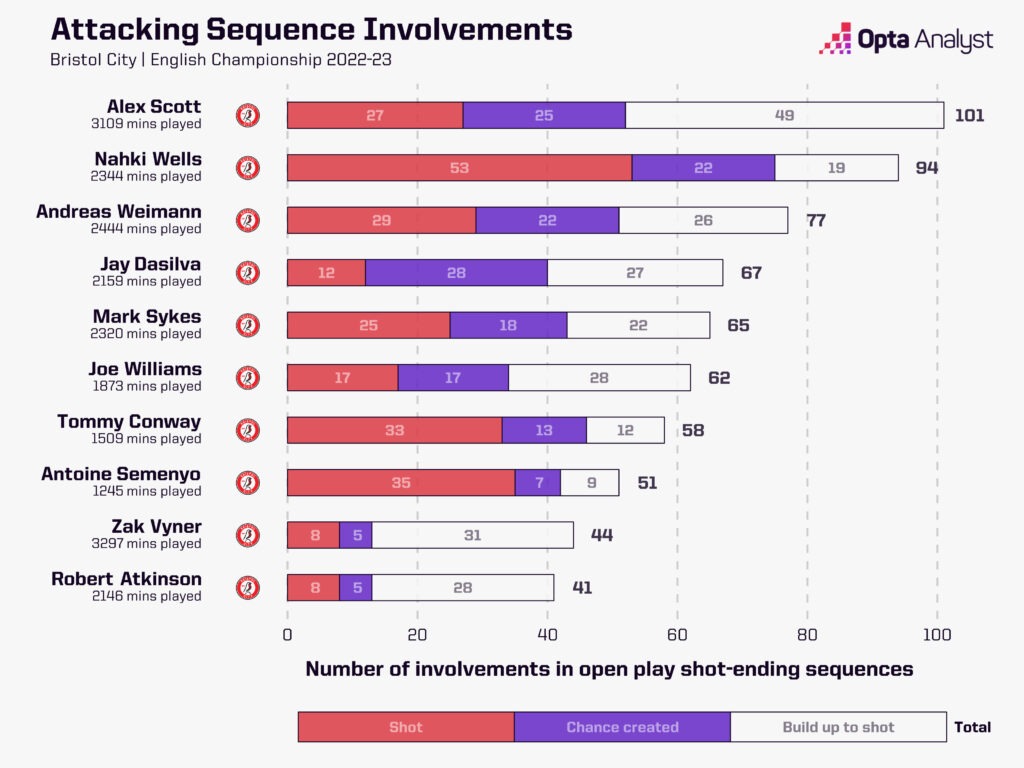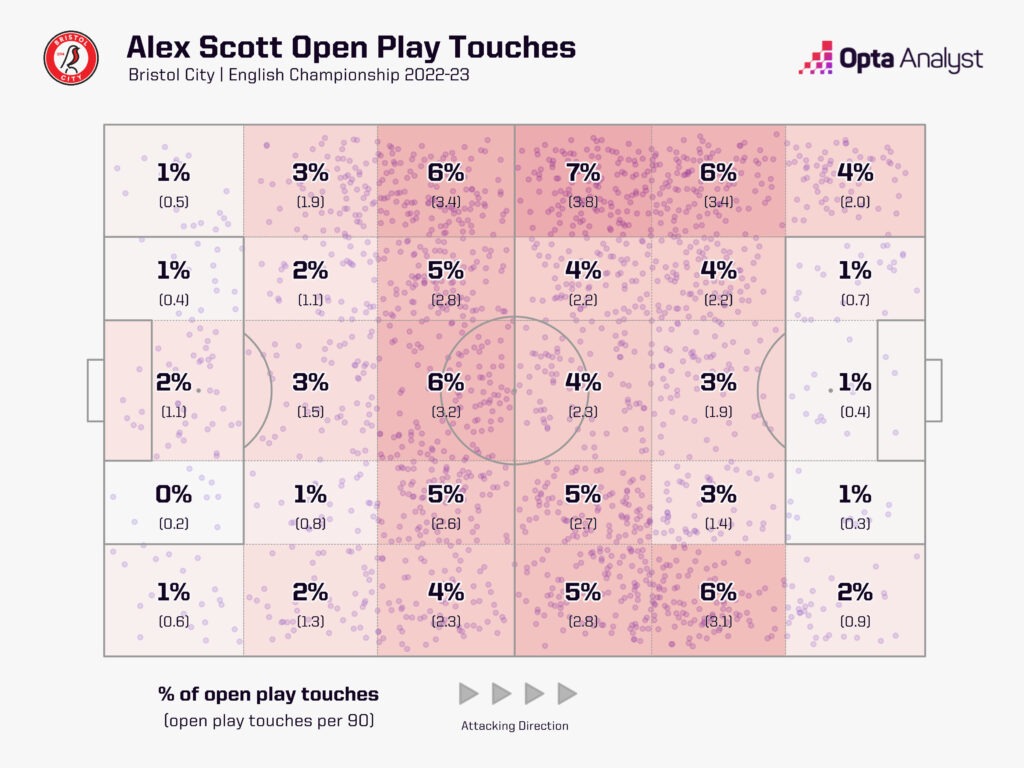Bristol City’s Alex Scott has rightly established himself as one of the EFL’s most prodigious talents.
The midfielder, who has represented England at three consecutive age groups up to the U20s –winning the European U19 Championship with the Young Lions last year – is best known for his close control and ability to glide with the ball at his feet.
On first glance, his ball-carrying numbers are solid, but not spectacular. Scott averages 12.8 ball carries per 90 minutes from central midfield, the fifth-most of anyone else to play his position this season (min. 2000+ minutes). These are penetrative carries too, with the youngster ranking 10th overall for progressive ball carries per 90 season (6.1) among the same cohort.
But when you start to factor in that he plays for a Bristol City side who are league-average for possession (48.9% – 13th-highest) and passes attempted per game (395 – 12th-highest), you begin to appreciate what a ceiling Scott might have. He’s been Bristol City’s do-it-all midfielder in possession so far this season, with his 22 chance-creating carries (13 when he’s taken the shot himself and 10 when he’s setup a team-mate) more than any other Robin.
His performances have not gone unnoticed and he’s a primary target for various Premier League clubs, including his boyhood team Tottenham, who he plays as when facing housemate and team-mate, Arsenal fan Tommy Conway, on FIFA.
Ball-Carrying Brilliance
On-the-ball event data can tell us how many times a player has dribbled, how far they’ve dribbled, and whether there was a shot or chance created at the end of it, which is often incredibly important. But sometimes, as in the case of Alex Scott, the interpretation of space by a player is arguably more important.
Scott can demand the ball under significant pressure, weave his way out of trouble and advance the ball to a more spacious area. That area might not always be much higher up than the previous position – it might not result in a shot, a key pass or a chance created – but it changes the dynamics of a passage of play.
So often Bristol City have been under pressure from the opposition and at risk of having the ball stolen from them in their own half one moment, yet the next, they have the means to build an attack of substance: all because of Alex Scott.
The teenager is fearless when he receives possession in his own half – only three other players in the division have completed more take-ons in their own half than Scott’s 47 – and these dribbles often mark the start of Scott getting his team out of trouble and onto the attack.
Based on the progressive carries viz below, the majority of Scott’s carries finish at a point that’s closer to the touchline than his starting position, which highlights his press resistance.
It’s easier for opponents to press the ball when it’s in a more central position because they can involve more players, but once the ball goes wide, that’s no longer possible and Bristol City have room to breathe.

As mentioned, Scott’s 6.1 progressive carries per 90 minutes in the Championship this season is ranked within the top 10 for central midfielders to have played at least 2,000 minutes of action. At Bristol City, only defenders Kal Naismith (8.7) and Cameron Pring (8.3) average more per 90, showing the importance of Scott in progressing possession up the pitch for the club.
Quality of performance is not just dictated by the volume of ball carries, or even the immediate end results of them, but whether they take a team from being vulnerable to being on the front foot: in Scott’s case, they undoubtedly do, consistently.
Tenacity
In this area of Scott’s game, the numbers are more revealing.
Praised by City fans for his excellent work rate, Scott averages more tackles per 90 than any other City player at 2.3 – only 13 Championship players have made more.
Across the Bristol City squad, Scott leads the club rankings for open-play possession starts (389), showing his positional awareness and ability to be in the right place at the right time, while he’s actively regained possession from opponents 127 times – only Zak Vyner (164) has done this more often at the club in 2022-23, as expected when playing in a deeper position than Scott.
Once he wins the ball back, Scott has the ability on the ball to launch City attacks. Only seven Championship players have started more open-play passing sequences that go on to end in a shot than his 33, which shows his defensive industry and ability to recover the ball for Bristol City before instigating penetrative attacks.
Scott doesn’t rank too highly across the league for such metrics, but that’s due to Bristol City not being a side known for pressing high up the pitch. They feature in the bottom eight for both PPDA (13.1 opposition passes allowed per defensive action on average) and high turnovers (248), both decent metrics as proxies for how intensely a team presses in the attacking half of the pitch.
If Scott is working his magic from a stage at which the opponents have just lost possession and are in a more vulnerable posture, the effect of his magic can be maximized. His energy and tenacity makes him a far more appealing proposition when it comes to his chances of getting a Premier League move, and it will give recruitment teams confidence that he can adapt to demands.
Adapting to Circumstance
Scott has already established himself whilst playing in a Bristol City side who sit mid-table in the Championship and, with respect, with players who are not at the same level as he is.
Naismith has struggled with injury since being recruited from play-off semi-finalists Luton in the summer, but when the versatile, cultured defender has been in the team, he’s been able to find the accuracy required to play Scott into some space.
When Naismith has been absent, City’s other defenders haven’t been able to offer the same qualities. As such, Scott has not had that space and has tended to have to turn the press, rather than receive already on the half-turn.
Often, Scott has coped incredibly well with that task and proved to be highly press-resistant, whilst getting his team into a position to start an attacking move. Either that’s through close control and beating a man, or on other occasions, he’s had to pop the ball off quickly to get things moving, because he’d otherwise get caught on the ball.
Despite these challenges, he has been involved in the build-up to 11 goals in the league this season, ranking inside the Championship’s top six – the only five players to be involved in more goal build-ups play for Burnley and Middlesbrough, who are the top two scoring teams in the competition in 2022-23 and have scored 24 (‘Boro) and 29 (Burnley) more goals than Bristol City (45).

Scott is involved in the process of creating high-quality chances for his side and excels in making the killer pass before the chance created for a shot or assist for a goal. Across the Bristol City squad this season, Scott has 27 secondary chances created in the Championship – 11 more than any other team-mate – with five of those leading goals. Don’t be fooled by his low goal (one) and assist (four) numbers – he’s integral to Bristol City’s goal threat, it’s just less noticeable to the ‘average’ viewer.

If Scott is playing in a better team, which doesn’t require him to get the ball rolling so much, he may get better quality service which may allow him to take his productivity up another level.
Versatility vs. Carving Out a Niche
Performing in multiple roles early in their careers can be helpful for a players’ development, especially if they have realistic aspirations of reaching the summit of the game.
In Scott’s case, he played much of last season at right wing-back, and he’s also played as a number 10, an eight and as part of a double-pivot, as well as in wide positions.
This variety of remits has enhanced his spatial awareness and understanding of the game: there’s already a real maturity about the way he plays.
For teams that play multiple formations, Scott’s versatility can facilitate switches, while the talent can also cover injuries and suspensions.
Though normally registered as a central midfielder, 47% of his touches in open play have been in the zones closest to the touchline, highlighting his ability to elude central challenges, find space out wide, and adapt to different phases of play.

This flexibility might hinder Scott in becoming a single-pivot, simply because his strengths necessitate not having strict positional discipline: if he drifted wide as a sole number six, his side’s defence would be vulnerable on turnovers.
On the other hand, Scott hasn’t yet threatened to score enough goals to justify being used consistently as a number 10, having played 20% of his minutes in attacking midfield this season.
He averages 0.06 xG per 90 minutes and averages just 0.9 shots per game when playing in central midfield.
In interviews, Scott has said that because he’s so busy and involved in general play in the middle third, it’s been difficult for him to then get into the penalty area, being so far away by the time the ball comes in.
As such, his efforts at goal tend to be speculative – one strike against Blackpool earlier this month is the extent of his seasonal tally.
That may well be down to his remit, so it’s possible that Scott can operate as a number 10 in a more possession-based side than Bristol City are and add more goals to his game. Having bagged four from wing-back in 2021-22, it could be in his locker.
Other teams may already have better quality in deeper areas, allowing the playmaker to influence proceedings higher up the pitch and add numbers to his game in the same way as Jack Grealish, who labelled Scott a “top, top talent”.
It’s not something he’s proven to do, yet, though, and playing a broadly unfamiliar role whilst making a huge step up to the Premier League might be a lot to ask in the short-term.
As such, it might suit Scott to play as part of a double-pivot, in a 4-2-3-1 or a 3-4-3, alongside someone more positionally disciplined, or perhaps in a 4-3-3 as a roaming playmaker, if there’s a midfielder who can sit deep, and another box-to-box type who can break into the box consistently.
Potential Suitors
Tottenham
The two main candidates to replace Antonio Conte at Spurs are Julian Nagelsmann and Mauricio Pochettino, both of whom favour a 4-2-3-1.
It’s a squad already well-stocked with midfielders, though, with Pierre-Emile Højbjerg, Rodrigo Bentancur, Yves Bissouma, Oliver Skipp and Pape Matar Sarr all vying for places, none of whom are on the decline or out of contract.
Spurs have priorities revamping a defence that’s shipped more than twice as many as Champions League rivals Newcastle and might not fancy spending £25M on a teenager from the Championship who might struggle to break into the matchday squad.
Manchester United
United have excelled in recent seasons by playing on the counter-attack, and that style of play has seen Marcus Rashford enjoy a fantastic individual campaign, but their passing has not always been as clinical.
Rashford’s pace has meant that Bruno Fernandes, Christian Eriksen, Casemiro and Lisandro Martinez have tried to spot the raking pass straight away – sometimes effectively, other times at the expense of smarter team play.
The Red Devils would be wrong to rely on Scott to find the level of consistency they need as a first-team regular in his debut season, but the hot prospect would bring something different to the midfield.
The fact that he isn’t always looking for the killer pass would allow the team to find their rhythm before attempting to cut opponents open.
Brighton
Scott hasn’t yet proven himself to handle the physical demands and intensity of the Premier League, so to give him the expectation of playing for Tottenham and Manchester United on top of that challenge would be a big ask.
Conversely, Brighton might be a great move for him, because while they are an extremely smart club and a team that’s incredibly well-coached, the pressure for success is not quite the same.
The Seagulls might need a midfielder, with star man Moisés Caicedo repeatedly linked with Arsenal.
Wolves
Turning 37 in September, João Moutinho is unlikely to play in 26+ league games next season.
Wolves may therefore need to source a mid-term replacement for the Portuguese veteran, while Ruben Neves, at 26, is approaching the last point of his career at which he could still command a sizeable transfer fee.
As such, there could be a gap in midfield for Julen Lopetegui’s side, who have been heavily linked with a move for Scott for four months.
Future With England?
Scott’s intelligent ball-carrying makes him an incredibly exciting prospect, described as one of the best players seen at Ashton Gate in over 30 years, but it’s important that he makes the right decision at this stage of his career.
He would do well to remember Jude Bellingham’s choice to pursue greater first-team opportunities at Dortmund, over the glamour of Manchester United. Make the correct call, though, and a huge future awaits, both at club level and with England.
Next summer’s European Championships might come too soon, but the midfielder will be 22 by the time the World Cup 2026 rolls around.
Gareth Southgate has been open to giving generational talents their opportunity, as we’ve seen with Bellingham, Declan Rice and Bukayo Saka. Plus, England’s current squad is arguably missing a deeper playmaker who can collect the ball off the defence and progress the ball into more spacious, favourable positions. There’s an argument to suggest that Rice, Bellingham and Scott in three years’ time could be the best midfield trio in world football. Hyperbole? Maybe. Within the range of outcomes? Certainly.
Enjoy this? Subscribe to our mailing list to receive exclusive weekly content. And follow us on Twitter too.
